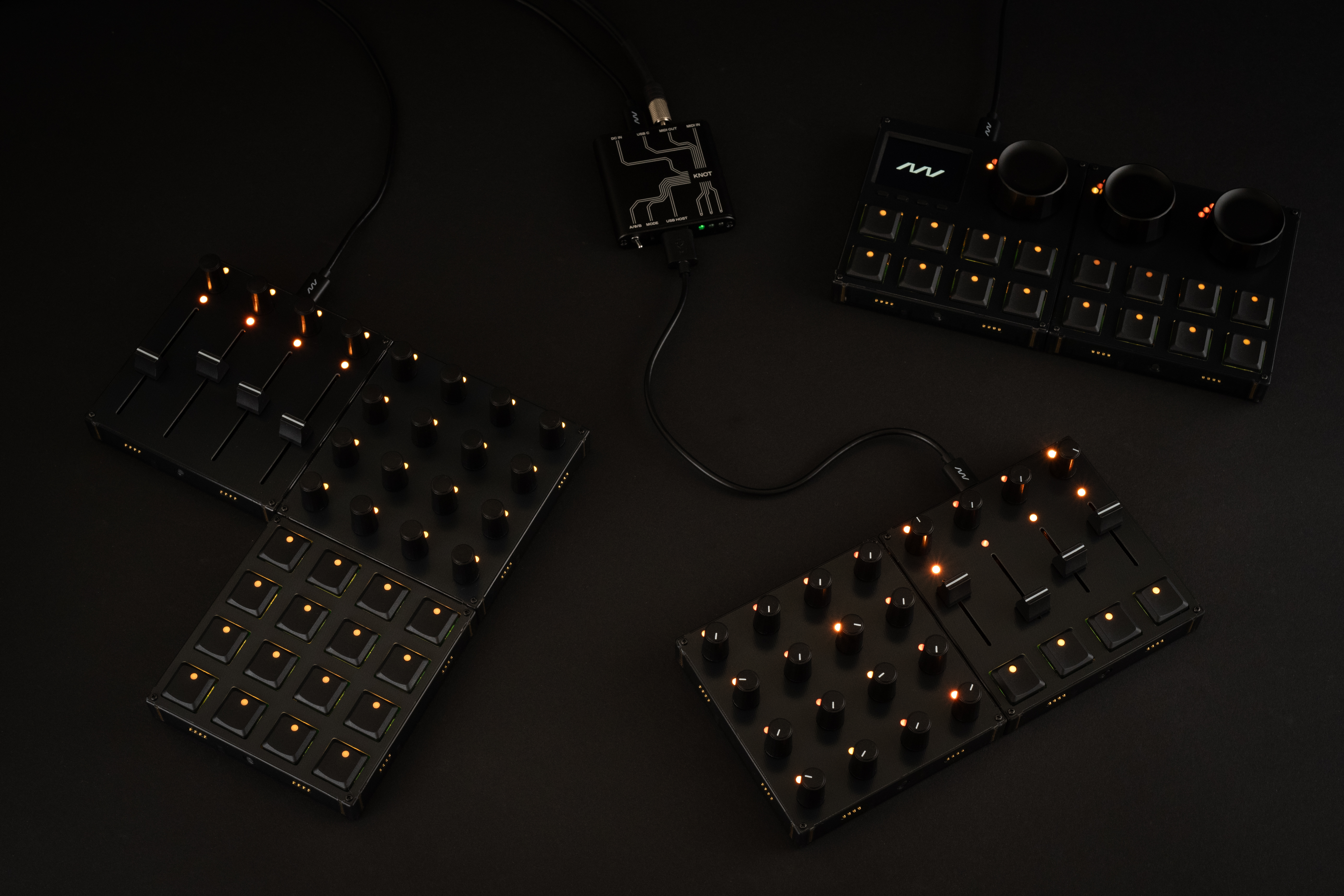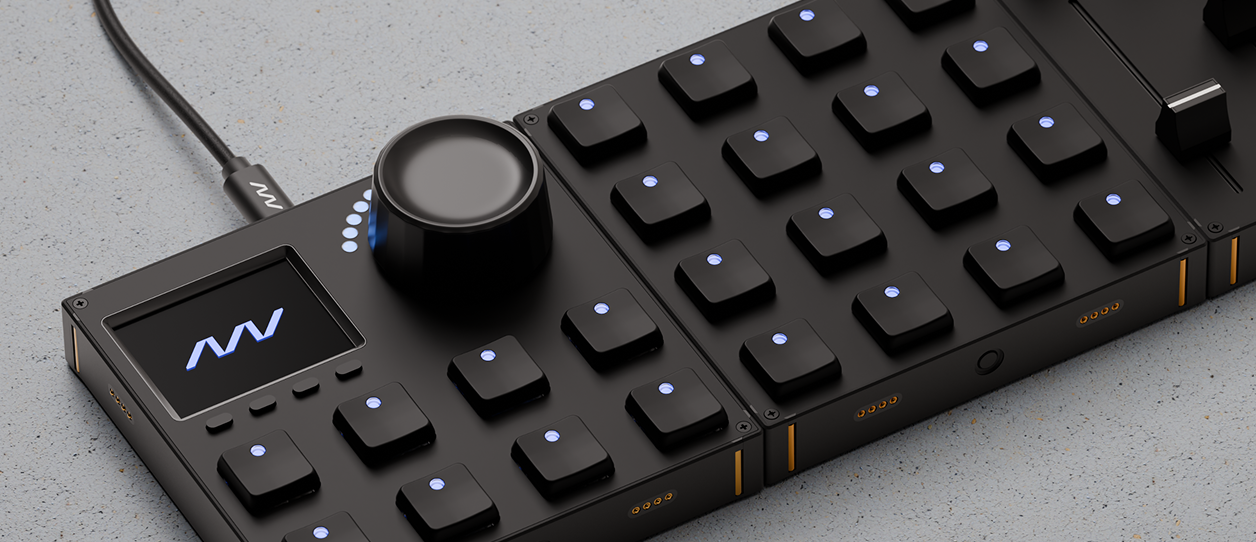
4x4 is all it takes to be in control.
Modular. Compact. Incredibly customizable.Built to fit your flow.
Grid is designed to grow with you. Start small or build a full custom setup—each module clicks into place with magnetic precision.
Find the control elements that best suit your workflow.
Master your craft using distinct creative solutions enabled by five different, yet standalone controller versions. Whether you’re looking for utmost precision control or dynamic real-time effects changes, Grid offers a wide variety of control elements. Take your time to find your perfect match of the classical fader, potmeter, encoder or button combinations.
Snap them together and go!
The golden magnets and tiny pins on each side create a stable and seamless connection through your entire modular Grid system. Once you hear them click-clack, the LEDs instantly light up.
Being compact and ergonomic at once? Sounds like a no-brainer to us.
Grid is all about portability. Its ultimately compact, yet ergonomic design allows for a flawless traveller's setup. Rearrange the Grids as many times as you like to find your ideal layout.
One module connects all – it’s just that simple.
Meaning that a USB C cable plugged into the module of your choice can power all the other Grid controllers in your setup. No default brain module required. Use it standalone or plug into your studio rig.
Map your controls in seconds.
Customize Grid to fit any DAW or MIDI supportive creative application with 4 different configuration settings mappable on the fly. Switch between four onboard setups on-the-fly with the designated mode button on the module’s side panel.
Grid is all about portability. Travel light.
Being compact and ergonomic at once? Sounds like a no-brainer to us. Its ultimately compact, yet ergonomic design allows for a flawless traveller's setup. Rearrange the Grids as many times as you like to find your ideal layout.
Upload your work & get inspired from the Profile Cloud.
The Profile Cloud available through the Grid Editor enables creators to upload, store and manage their work cloud-based. Save your controller’s profile settings for later, or share it for others to collaborate.
Access your presets anywhere.
Thanks to Grid’s four-page memory you can access your work anywhere without ever having to open the Editor software. Switch between configuration pages with the designated mode button on the side, or map any button or encoder control element to do the same.
Forget clutter. All you need is a single USB-C.
Grid modules connect magnetically and draw power from a single USB-C cable. Without the need for a hub, one cable enables control over your whole Grid setup, and supplies enough power for up to 8 modules connected together. Above that we recommend using an additional charging cable
Compatibility with any creative application.
Grid works with any creative application—from Cubase and Studio One to Final Cut Pro or Lightroom. Whether you're editing audio, video, or visuals, Grid fits right into your workflow with ease thanks to its fully customizable controls.





Diverse controlling possibilities without the background noise.
Set up your USB MIDI, mouse, keyboard, or gamepad once and save it to Grid—no drivers needed. For advanced setups, use the Editor to connect your controller with your favorite apps.
Multi-platform support
Grid works seamlessly on macOS (Intel & Apple Silicon), Windows, Linux, and even mobile platforms—with real, personal support to help you every step of the way.
Explore the power of unlimited customization
The Grid Editor enables a highly-customizable controlling solution through in-depth programmability in its LUA code. It serves as a completely free and open-source hub for expanding your hardware’s potential.
screen
The Grid VSN controller's 320x240 RGB screen enables pixel-perfect UI for custom parameter showcases. Display texts, rectangles, states, values, and procedural graphics. Reusable blocks simplify common displays. A VSN screen module automatically reads data from itself or other connected modules.

potentiometer
Potentiometers are rotary knobs with a physical start and end point, meaning you can only rotate them through a limited range, in our case a 300 degree turn. Thanks to their smooth rotation, yet constant physical resistance while turning, potentiometers are ideal for continuous motion changes like volume or filter cutoff, however they are not suitable for discrete settings where you need to select specific values with precision. If you are a sound-design enthusiast, look no further, our PO16 Grid module will be your best friend.
encoder
Detent encoders are equipped with push functionality in addition to their infinite rotation. Meaning that they pack both a two-state switch (pressed & released) and a 20 click per resolution endless encoder knob in a small form factor. Combining these two digital elements allows for multitudes of parameter control on just a single encoder element. In general encoders are a great choice for controlling dynamic adjustments in live performances by manipulating software effects. Encoders can also help you to avoid annoying parameter jumps, by generating incremental values based on the direction and speed of rotation.
endless encoder
Grid's endless rotary pots offer refined control. 5-seg LEDs give clear parameter feedback. Their machined metal knobs are engineered for balance, comfort & a secure no-slip grip—ideal for intense sessions. Press for micro fine-tuning or to swiftly jump views/parameters with a simple nudge. Ergonomic & precise.
button
Buttons usually control basic, two-position functions, such as on-off states. Start several tracks at the same time with just one push, launch clips or switch effects. However, they can be put to a more versatile use, when mapped with shortcuts, functioning as a productivity tool. Buttons can even play the role of steps in a MIDI sequencer with the right configuration, communicating with your DAW.
fader
When it comes to faders, Grids use two lengths: EF44 boasts longer, 60 mm smooth travel, linear faders, while the PBF4 module is built with 30 mm elements. The encoder-fader module version enables a gradual and a controlled transition between two machine states, controlling a buildup before the drop for instance. On the other hand, the short fader is beneficial for instant tactile changes, such as controlling the audio levels of a mixer for both quick mutes and slower fade-ins.